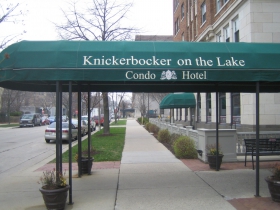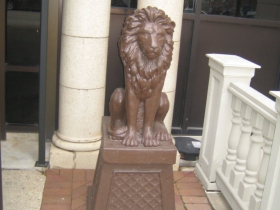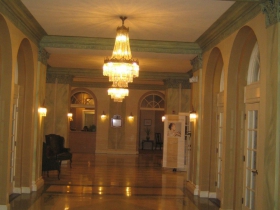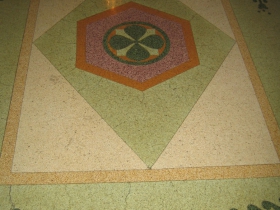John McGivern’s $1 Million Apartments
Comedy pays, it turns out. The entertainer owns 11 apartments totaling 7,572 square feet.
Milwaukee native John McGivern returned to his hometown about 20 years ago and has made a living since telling audiences here and elsewhere humorous stories about his life. He has also performed in numerous plays and presentations, and was most recently host of the 100th annual City of Milwaukee Holiday Tree Lighting ceremony. He also has a public television series about Milwaukee neighborhoods. He had 57 IRS Form 1099s to file last year.
What Harpo Marx said of Alexander Woollcott applies to McGivern — “He is just a big dreamer … with a good sense of double-entry bookkeeping.”
Beginning in 2002, McGivern has parlayed his extra cash into purchasing apartments in the Knickerbocker on the Lake Condominiums, 1028 E. Juneau Ave. at the rate of about one per year. The 11 properties he owns outright are assessed at $1,006,900 by the city. [McGivern also holds an ownership share in another unit in the building, formerly the Knickerbocker Hotel.]
Most of the McGivern units are on the small side — say 430 sq. ft. to 460 sq. ft. as befits their former hotel status. These are assessed in the range of $55,000 or so. McGivern buys them and his partner Steve Brandt fixes them up.

John McGivern in his Knickerbocker On The Lake residence. Photo by Rose Balistreri.
McGivern’s own unit, #625, is much larger than most at 1,998 sq. ft. He moved there from one of his other, smaller units, to take advantage of its view of the lakefront and downtown. His unit has two bedrooms and two baths, and has been featured in news stories. McGivern has also opened the apartment to tours during Doors Open Milwaukee, where he showed guests his place and walked them around the 1927-1929 building.
McGivern bought this unit in 2009, paying $295,000 for it. It is now assessed at $294,000 and is taxed at $8,726.08, with the amount owing being paid in full.
The other units are rented, usually to corporate and theatrical clients, which gives John McGivern that much more to do each day, and even more 1099s to file.
Altogether, McGivern’s Knickerbocker holdings amount to some 7,572 square feet, and represent better than 5 per cent of the building’s 204 apartments. He is by far the largest real estate holder in the building, owning more units than the Knickerbocker Condominium Association itself.
About the Knickerbocker Hotel
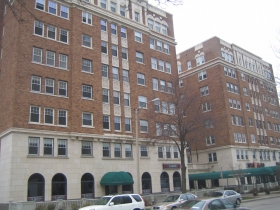
Knickerbocker On The Lake. Photo by Michael Horne.
The surrounding neighborhood was long known as Yankee Hill by the time the Knickerbocker [1927-1929] and Hotel Astor [1920] were built on neighboring blocks of E. Juneau Ave., adding even more Yankiness to the area. The two buildings are residential hotels of a style more commonly associated with the east coast, as is the neighborhood’s abundance of Protestant churches, including two Episcopal churches just a block apart. In their prime, the Knickerbocker and Astor were convenient to downtown and the train stations. Residents included day travelers in the small rooms, and long-term tenants in the larger units, like McGivern’s. Today’s residents tend to be long-term, but some, like Milwaukee Journal Sentinel art critic Mary Louise Schumacher, rent their units out when not needed. [See Plenty of Horne, November 21st, 2013]
One established tenant was Lucius Nieman, longtime editor of the Milwaukee Journal, who died there after a long illness in 1935.
The next year his wife, Agnes Wahl Nieman, wrote a will that provided for her residual estate to be given to Harvard University to establish a journalism fellowship. That was on February 1st, 1936. She was dead within a week.
Her bequest amounted to over $1,000,000, and the Harvard Nieman fellowships are one of the premier prizes in academia, offering working journalists a chance to spend a year at Harvard.
In the 1960 presidential election, the hotel was the headquarters for the Democrat Hubert Humphrey’s campaign during the primaries, and was a resting point for Republican vice presidential candidate Henry Cabot Lodge in October 1960, while he and his wife were on the campaign trail.
In 1980, the building was proposed to be converted into condos by its owner Oliver Plunkett. This started a reaction from the building’s tenants, many of them elderly, and many of whom gathered in the downstairs coffee shop – pharmacy (now The Knick). Pharmacist Jim Searles rallied the tenants, and eventually reached a court agreement that allowed 100 tenants to live in the building for another three years.
By 1984, Searles lost his lease on the building and set up shop on Brady Street, where his Brady Street pharmacy operated until it became Glorioso’s Italian Market in 2010.
The hotel also was the longtime home to Sally’s Restaurant, operated by Sally Papia, known as the “Queen Bee of Milwaukee’s Organized Crime” and was a popular gathering spot for a rather wide mixture of people. Sally’s site is now Il Mito East Restaurant.
The Rundown
- Style: Classical Revival Apartment Building
- Architects: Rossman and Wierdsma, 1927
- Location: City of Milwaukee
- Neighborhood: Yankee Hill
- Walk Score: 89 out of 100. “Very Walkable. Most errands can be accomplished on foot.”
- Street Smart Walk Score: 91 out of 100 “Walker’s Paradise”
- Transit Score: 62 out of 100.
- Size: 1,998 square feet
- Year Built: 1927-1929
- Assessed Value: Land — $4,800; Improvements — $289,200 Total $294,000
- Taxes: $8,726.08, paid in full.
Photo Gallery
House Confidential Database
| Name | City | Assessment | Walk Score | Year |
|---|---|---|---|---|
| Name | City | Assessment | Walk Score | Year |


